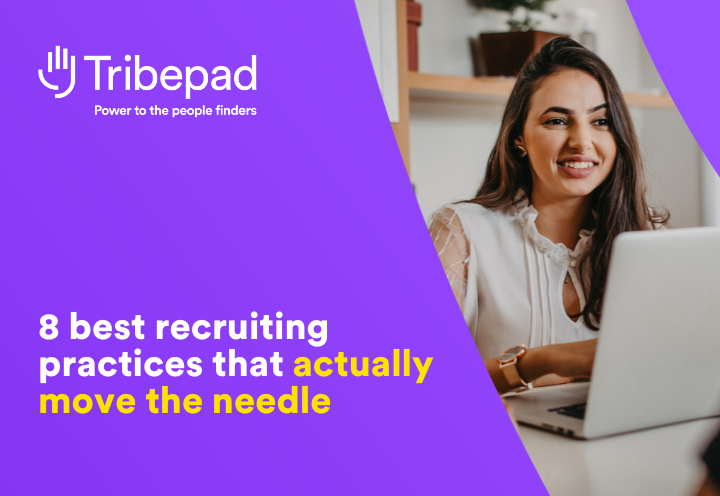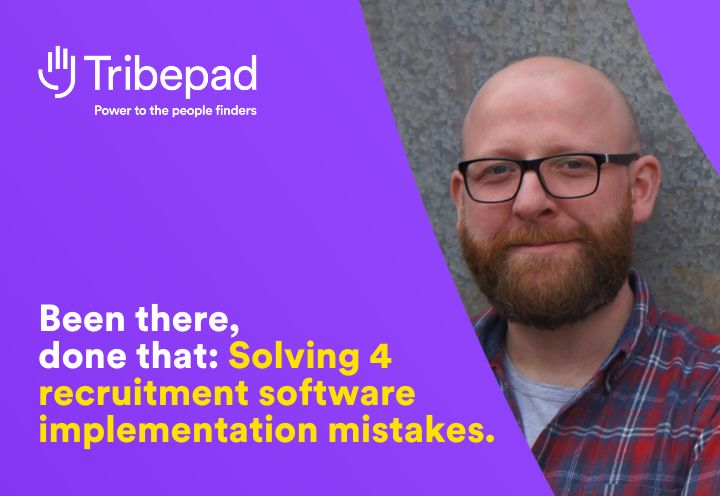The exact steps in the hiring process differ by organisation and role. But there’s more that’s similar than different. In this article, we’ll talk about what those steps typically look like — and share some common opportunities to make them fairer, faster, and better for everyone.
The most common steps in the hiring process look something like this:
- Identify the hiring need
- Formulate a hiring plan
- Write a job description
- Create a job advert
- Create an application journey
- Advertise the role
- Source talent
- Screen talent
- Review applications
- Conduct live interviews
- Make your decision
- Run compliance checks
- Make a job offer
- Onboard 🎉
- Learn and refine
You might combine (or break out) steps or vary the order slightly, but in principle those are the steps that’ll give yourself the best chance of building a safe, reliable, and effective hiring function.
Let’s look at each of those – with suggestions to make them fairer, faster, and better, if they’re a sticking point.
How to improve the 15 common steps in the hiring process
1 – Identify the hiring need
Hiring starts when you identify a need to hire (to state the obvious). The hiring need should relate to the organisation’s goals and business plan. Some common drivers for hiring:
- Fulfilling your strategic hiring plan
- Backfilling because someone’s left
- Preparing for someone critical to leave
- Accommodating growing workloads
- Meeting changing skills requirements
Optimising 🛠️:
This step is your starting gun. If the organisation runs slow here, it’ll have a negative effect on every other stage in the recruitment process. To get off the blocks faster, review your internal sign-off processes and culture.
- Are managers empowered and trusted to flag when they need someone?
- How long does it take to submit and approve requisition requests?
- How many stages of sign-off do you need, and are they automated?
- Is the requisition process coherent and consistent, or black-box?
- How soon after employees hand-in notice do you start hiring?
- Do you have visibility over your leadership pipeline?
- How are budget decisions made for unexpected headcount?
Asking questions like this can help you spot where you can accelerate decision-making, so recruiters can start recruiting faster.
2 – Formulate a hiring plan
This mightn’t happen every time. It’s likely you’ll have an overarching hiring strategy for certain types of roles, like volume recruitment. But this stage is critical because it’s your blueprint for how hiring’s going to happen. (And the agreement you can wave to keep people on-track if they start deviating and dropping balls).
Optimising 🛠️:
This is one of those steps in the hiring process that takes time upfront but saves time later. Don’t skip or skimp. You’re much more likely to get waylaid by time-consuming detours if you don’t have a good map.
Pin down who’s doing what, when, and how fast they’ll commit to doing it. This is where you bake-in accountability. Before starting to actively recruit, you should know:
- Who’ll be involved, when?
- What internal SLAs have you agreed? (AKA how fast will people do stuff)?
- What will the hiring process involve?
- What are the nuts and bolts of the role?
3 – Write a job description
Next up, you’ll need a job description. TA teams sometimes treat this stage like an admin hoop before recruitment can start. But it’s much more than that. A good JD is critical to successful hiring because:
- It clarifies roles, responsibilities and expectations on both sides
- It streamlines the hiring process by attracting more qualified talent
- It’s the foundation for effective performance management
Optimising 🛠️:
Hours (and patience) vanish fast if you’re starting from scratch. But a good JD shouldn’t just be a copy-and-paste job, based on outdated specs. It’s too important to job performance.
Look for a balance between automation and human input. A good applicant tracking system should automate all the bits recruiters don’t need to do, so you can spend more time doing the things you do.
Like:
🧑🦰 Work closely with managers to get under the skin of roles
💻 Store pre-approved job templates with locked mandatory fields
💻 Use AI to suggest appropriate skills for each role
💻 Clone jobs with a click for when you’re recruiting on repeat
4 – Craft a job advert
Now the fun bit starts, where your internal processes start turning outwards. But boring job adverts get lost in the noise, shooting your chances of high-quality applications in the foot. (Especially if they’re a copy-paste of a JD that’s already a copy-paste from another JD).
But creating something unique, engaging, and inclusive takes time. And every delay can cost candidates.
Optimising 🛠️:
There’s no excuse for generic, boring, slow-to-create job ads, nowadays. If you’re struggling, that’s a good sign you’re not using the right recruitment software. Your ATS should make it easy to get gorgeous, rich media job ads live almost instantly. Some of the value-add stuff to look for:
- AI-powered ad creation
- Ad templates
- Drag-and-drop editor
- Automatic bias checking
- AI skills suggestion
- Rich-media additions
- Joined-up analytics
Read how Well Pharmacy overhauled job adverts with Tribepad (and what they achieved when they did…)
5 – Create an application journey
So… you’ve identified the need to hire, your plan for hiring, the JD you’re hiring against, and you’ve written a lovely ad to showcase that to the world. But now what? What happens to candidates as they enter your process?
Because you need the info you need, right? But clunky forms, yawn-inducing journeys, and endless questions tank completion rates.
Optimising 🛠️:
If you’re struggling with completion rates, the problem is typically either tech or internal process. Or some combination of both. Some best practices for more completions (and happier candidates):
- Personalise application journeys for different roles
- Make applying simple, not arduous
- Use mobile-friendly, responsive tech
- Prioritise inclusivity and accessibility
- Empower candidates to save and track progress
- Include good instructions for candidates who might need help
- Choose tech that’s modern and fresh (especially if you gather lots of info)
- Review which info you really need to gather 👀
Read how Tesco process 2.8 million applications annually with Tribepad
6 – Advertise the role
Your job ad’s ready. Now you need to show it to the world. Except, not actually the world because that’d be expensive. That’s the crux of this step of the hiring process. Getting your job advert across enough of the right eyeballs, without hitting too many of the wrong ones.
Optimising 🛠️:
Manual posting is a no-no – it’s far too time-consuming (not to mention soul-destroying). Even basic recruitment software should come with automated multi-board distribution now, which saves literally a bazillion hours if you’re still posting manually. Even better, look for programmatic matching, to boost efficiency and post where it pays off.
Explore Tribepad for Recruitment Marketing
Don’t forget to advertise internally too. And encourage employees to spread the word too, with an employee referral program. Your people can be force multipliers for distribution.
7 – Source talent
This is the stage where you go actively looking for candidates, while you’re waiting for applications to roll-in. Some usual hunting grounds:
- Your candidate database
- Your talent pools
- Social media
- Job boards
- Headhunting
- Agency support
Optimising 🛠️:
Your database and talent pools are first on the list for a reason. But many teams aren’t harnessing their database properly. Unlock value from your biggest asset, by:
- Searching better
- Nurturing talent pools
- Calling ‘stale’ CVs
- Upskilling your recruiters
Once you’re exhausted your own internal talent lists, then it makes sense to start looking externally. But remember that sourcing isn’t just a numbers game. Sending 1000 generic InMails (a la many agency recruiters) isn’t usually a productive use of time.
8 – Screen talent
Candidate screening is one of the steps of the hiring process that has most variance across teams and roles. You might…
- Embed screening into the application journey
- Run detailed psychometric tests
- Conduct phone screening
- Run video screening
- Some combination of the above
Optimising 🛠️:
Whatever your exact approach, screening can be radically transformed by the right tech. For instance, video screening can slash time-to-hire by a third and work wonders for ED&I. But it’s also a sensitive area, because there’s lots of scope to over-rely on technology here.
Tech should never make hiring decisions. It should surface and synthesise more data, more quickly, sure. But so a human recruiter can use that data to guide better human decisions.
For example:
❌ Using AI to score and automatically reject failing candidates
✅ Using AI to score candidates, with detailed and transparent summaries
9 – Review applications
As applications arrive (and/or after screening), you’ll need to review them and decide if they progress. That typically involves a combination of your ATS, you, and your managers. For example, your ATS might screen out candidates who don’t have the right to work in the UK but you might want manager eyes-on every video interview.
This stage of hiring is often where fair and fast start becoming pipedreams, as managers delay and biases creep in.
Optimising 🛠️:
Optimising this stage is a process, people, and tooling challenge. Start from the strategy: how do you ideally want reviewing to happen? When? Who’s involved? Then look at how you’re enabling that.
If managers are going quiet, for example, do they have the training and tools to do what you want? Does your recruitment tech make their lives easy or harder? Is collaboration automated or messy and manual?
10 – Conduct live interviews
You might have anywhere from one to several (or more) interviews, depending on your organisation’s size, interviewer availability, role, seniority, and location. The live interview process for a remote graduate role will naturally be very different from a global Head Of.
Optimising 🛠️:
Whatever your process, it’s good practice to ask if you genuinely need as many stages as you think. Or as much space between them. You might. But also, maybe you could corral all your decision-makers for a day and run back-to-backs. Food for thought.
Live interviews are also where fairness can go majorly off-track, with inconsistency and bias becoming major threats. Training can help mitigate. As can the right tech, creating candidate scorecards from your JD so everyone’s on the same page and captures notes centrally.
11 – Make your decision
Self-explanatory but often not simple. Final decisions are often fraught with stakeholder disagreement and delay.
If nobody can agree, you might have too many good candidates (nice problem!). Or cracks in the hiring brief have started to show, and you’ll need to consider going back to the drawing board (nasty problem!).
Optimising 🛠️:
Transparent, consistent, centralised data is your friend here. Decisions are a whole lot harder if random notes are spread across notepads, email, and Slack channels. As opposed, consistent scores in a consistent framework that everyone relevant has had input into. (With a clear audit trail, to prove they’re had input).
12 – Run compliance checks
The level of scrutiny you apply will depend on your industry. But in any case, this is one of the most essential steps of the hiring process, making sure you’re hiring who you think you’re hiring.
Typical checks and balances include:
- DBS checks
- Right to Work checks
- Identity checks
- Work history checks
- Financial checks
- Social media checks
- Reference checks
Optimising 🛠️:
Background checks are notorious for snarling up the candidate journey and slamming the brakes on hiring. But they don’t need to be.
Look for digital identity checks partners who integrate seamlessly into your recruitment software, for results you can trust, fast. Bonus points if you prioritise providers who offer a fast, modern candidate experience, not something from the Dark Ages. (There’s still a lot of that about).
Read how HCRG Care Group reduced time-in-compliance by 62% with Tribepad
13 – Make a job offer
Almost at the finish line! Now’s where you create an offer letter, laying out the T and Cs of the job. It sounds simple but it can be a Herculean task riddled with version control headaches, editing nightmares, and unrealistic demands on candidates to, you know, own a printer in 2025.
Optimising 🛠️:
Get alignment upfront about what, if anything, is negotiable. Would remote working be an option for your dream candidate, or is it an absolute no-go? Would you pay 5% more? Knowing what’s moveable upfront saves chasing, hassle, and frustration that can hurt offer acceptance rates.
On the practical side, you’ll find contract management a bucketload easier with the right tech to support. Good stuff includes:
- Drag-and-drop contract builder
- e-signatures
- Bulk contract editor
- Automated field population
- Template library
- Contract cloning
- Transparent audit chain
14– Onboard 🎉
Onboarding often falls into the grey area, after recruitment has tapped out but before anybody else has tapped in. Good onboarding matters because:
⬆️ New hire retention
⬆️ New hire engagement
⬆️ New hire productivity
⬆️ TA’s credibility and impact
and
⬇️ Rework
⬇️ Churn
⬇️ Costs
⬇️ Awkward questions
Onboarding is how you transition candidates into employees who add value for years. It’s the glue between recruitment and HR and performance management.
Optimising 🛠️:
Onboarding can’t afford not to be on recruiters’ radar, even if the accountability is blurry. Think about these onboarding best-practices:
- Define clear lines of responsibility
- Track accountability
- Automate, automate, automate
- Give candidates a self-service hub
- Engage, as well as inform!
- Choose the right onboarding tool
15– Learn and refine
Congratulations! You’ve made a successful hire. But before you go back to the start of the cycle, take a moment to analyse, evaluate, learn and refine.
- What worked?
- What didn’t work?
- What should you tweak for next time?
This is how you build a recruitment function that’s not just functioning but continually improving.
Optimising 🛠️:
The big blocker here is that many TA teams don’t have the right recruitment data. Whether you’re an enterprise or an SME, better recruitment reporting empowers better recruitment. Better:
✔️ Hiring decisions
✔️ Stakeholder management
✔️ Case for funding
✔️ Candidate experience
✔️ Manager experience
✔️ ED&I outcomes
✔️ Cost-efficiency
✔️ Recruiter marketability 👀
Your recruitment tech should ingest data about everything you do, and then output clear, easy-to-understand reports that help you spot improvements, solve issues, and strategise better.
The right tech matters, but humans are the foundation
You’ll have noticed throughout this list that having the right recruitment software is, undeniably, a critical piece of the hiring optimisation puzzle. But tech isn’t a magic bullet. Adding the right tech onto the wrong processes just gives you poor processes faster.
Start from the foundation – your team – and build from there. Look across the steps in the hiring process to spot inefficiencies baked-into how you work. Then design a better process, that harnesses recruitment software as an enabler.
Tribepad is the trusted tech ally to smart(er) recruiters everywhere. Combining ATS, CRM, Video Interviewing, and Onboarding, our talent acquisition software is a springboard for fairer, faster, better recruitment for everyone.
Trusted by organisations like the BBC, Tesco, NHS Professionals, and Subway, 30-million people in 16 languages use Tribepad.




